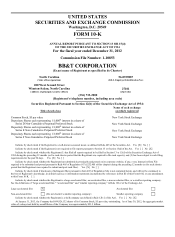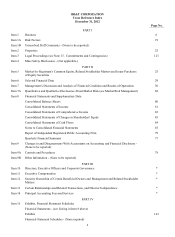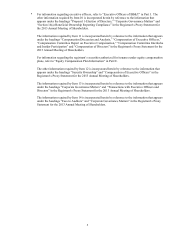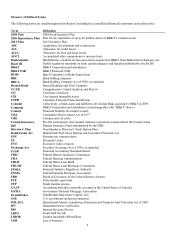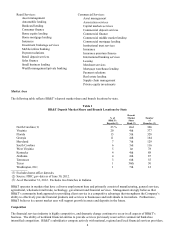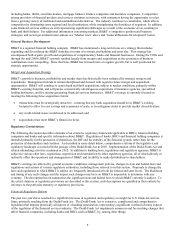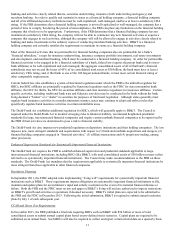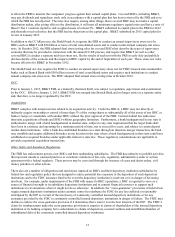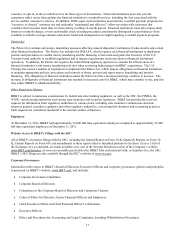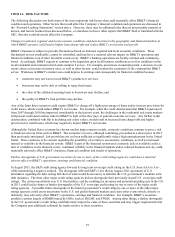BB&T 2012 Annual Report Download - page 31
Download and view the complete annual report
Please find page 31 of the 2012 BB&T annual report below. You can navigate through the pages in the report by either clicking on the pages listed below, or by using the keyword search tool below to find specific information within the annual report.
9
including banks, thrifts, securities dealers, mortgage bankers, finance companies and insurance companies. Competition
among providers of financial products and services continues to increase, with consumers having the opportunity to select
from a growing variety of traditional and nontraditional alternatives. The industry continues to consolidate, which affects
competition by eliminating some regional and local institutions, while strengthening the franchises of acquirers. In addition,
some financial services entities are still experiencing significant challenges as a result of the economic crisis, resulting in
bank and thrift failures. For additional information concerning markets, BB&T’ s competitive position and business
strategies, and recent government interventions see “Market Area” above and “General Business Development” below.
General Business Development
BB&T is a regional financial holding company. BB&T has maintained a long-term focus on a strategy that includes
expanding and diversifying the BB&T franchise in terms of revenues, profitability and asset size. This strategy has
encompassed both organic growth and acquisitions of complementary banks and financial businesses. During the 1990s and
through the mid-2000s, BB&T’ s growth resulted largely from mergers and acquisitions as the economics of business
combinations were compelling. Since that time, BB&T has focused more on organic growth, but is well positioned for
strategic opportunities.
Merger and Acquisition Strategy
BB&T’ s growth in business, profitability and market share has historically been enhanced by strategic mergers and
acquisitions. Management intends to remain disciplined and focused with regard to future merger and acquisition
opportunities. BB&T will continue to assess bank and thrift acquisitions subject to market conditions, primarily within
BB&T’ s existing footprint, and will pursue economically advantageous acquisitions of insurance agencies, specialized
lending businesses, and fee income generating financial services businesses. BB&T’ s strategy is currently focused on
meeting the following three acquisition criteria:
transactions must be strategically attractive – meaning that any bank acquisition should be in BB&T’ s existing
footprint to allow for cost savings and economies of scale, or in contiguous states to provide market diversification;
any credit-related issues would need to be addressed; and
acquisitions must meet BB&T’ s financial criteria.
Regulatory Considerations
The following discussion describes elements of an extensive regulatory framework applicable to BHCs, financial holding
companies and banks and specific information about BB&T. Regulation of banks, BHCs and financial holding companies is
intended primarily for the protection of depositors, the DIF and the stability of the financial system, rather than for the
protection of shareholders and creditors. As described in more detail below, comprehensive reform of the legislative and
regulatory landscape occurred with the passage of the Dodd-Frank Act in 2010. Implementation of the Dodd-Frank Act and
related rulemaking activities continued in 2012. In addition to banking laws, regulations and regulatory agencies, BB&T is
subject to various other laws, regulations, supervision and examination by other regulatory agencies, all of which directly or
indirectly affect the operations and management of BB&T and its ability to make distributions to shareholders.
BB&T’ s earnings are affected by general economic conditions, management policies, changes in state and federal laws and
regulations and actions of various regulatory authorities, including those referred to in this section. Proposals to change the
laws and regulations to which BB&T is subject are frequently introduced at both the federal and state levels. The likelihood
and timing of any such changes and the impact such changes may have on BB&T is impossible to determine with any
certainty. The description herein summarizes the significant state and federal laws to which BB&T currently is subject. To
the extent statutory or regulatory provisions are described in this section, such descriptions are qualified in their entirety by
reference to the particular statutory or regulatory provisions.
Financial Regulatory Reform
The past two years have resulted in a significant increase in regulation and regulatory oversight for U.S. financial services
firms, primarily resulting from the Dodd-Frank Act. The Dodd-Frank Act is extensive, complicated and comprehensive
legislation that impacts practically all aspects of a banking organization, representing a significant overhaul of many aspects
of the regulation of the financial services industry. The Dodd-Frank Act implements numerous and far-reaching changes that
affect financial companies, including banks and BHCs such as BB&T, by, among other things:




